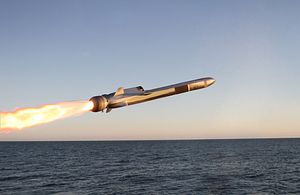The U.S. Navy has deployed the Independence-class littoral combat ship (LCS) USS Gabrielle Giffords to the Indo-Pacific region carrying the fifth-generation over-the-horizon Naval Strike Missile (NSM), according to U.S. Navy officials.
The trimaran deployed on September 3 from its homeport in San Diego, California. Defense News first reported the deployment.
The USS Gabrielle Giffords was commissioned in June 2017. The LCS is named after former U.S. Congresswoman Gabrielle Giffords who survived an assassination attempt in 2011.
The U.S. Navy’s LCS fleet consists of the Independence and Freedom class. Both variants are armed with a 57-millimeter naval gun and a 11-cell Raytheon RIM-116B SeaRAM missile-defense system.
The entire LCS fleet will also be equipped with the Surface-to-Surface Missile Module, a 24-shot AGM-114L Longbow Hellfire missile vertical launch system, with initial operational capability expected by the end of 2019.
According to a report by the Pentagon’s office of Operational Test and Evaluation from January 2018, neither LCS variant is suitable for high-intensity combat in present configuration.
Consequently, U.S. defense contractor Lockheed Martin has been spearheading a two-phased plan for “up gunning” both the Freedom and Independence variants of which adding the fifth-generation over-the-horizon NSM to the LCS’ arsenal is a crucial component.
Norway-based Kongsberg Gruppen and U.S. missile maker Raytheon Company were selected earlier this year by the U.S Navy to install the NSM aboard most LCSs by 2023.
The NSM is reportedly being installed on the deck of each LCS in proprietary canister launchers.
Each LCS can be armed with up to eight NSMs. Overall, the U.S. Navy intends to procure 64 NSMs by 2023 with follow-on orders expected. It is unclear how many NSMs the USS Gabrielle Giffords carries for the duration of the warship’s deployment to the Indo-Pacific region.
As I reported earlier this year:
The NSM is the successor to Kongsberg’s Penguin short-to-medium range anti-ship guided [cruise] missile. The missile, featuring an imaging IR-seeker and inertial/GPS navigation, can strike both sea and land targets at a distance of around 185 kilometers (100 nautical miles). Carrying a 125-kilogram (276 pounds) multi-purpose blast/fragmentation warhead, the NSM is capable of reaching high subsonic speeds and can approach its targets in sea skim mode.
The NSM, the U.S. Navy’s first new anti-ship missile in decades, is paired with a MQ-8B Fire Scout helicopter drone used for scouting over-the-horizon targets. The Fire Scout achieved its initial operational capability in June. The Gabrielle Gifford was retrofitted with both systems earlier this year.
The LCS fleet will also be equipped with a Surface Electronic Warfare Improvement Program, the Nulka MK 53 Decoy Launching System, and the Mk 48 Mod II Gun Weapon Control System to improve the performance of the surface combatant’s 57-millimeter naval gun.
In June, the U.S. Navy, for the first time after a 19-months lapse in deployments, dispatched the Independence-class LCS USS Montgomery to the Indo-Pacific region.

































